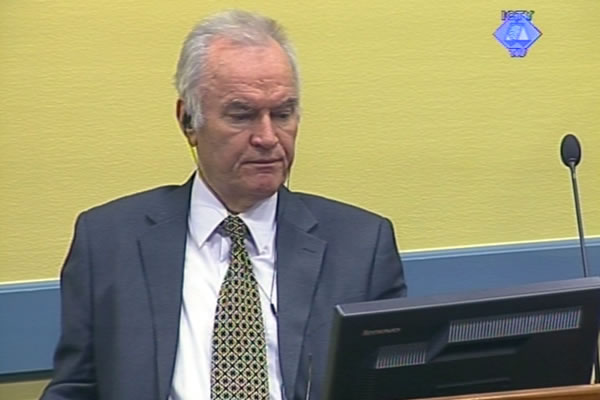Home
MLADIC SHOWS HE IS IN GOOD SHAPE
In the break between two sessions, Ratko Mladic did several push-ups in the dock, probably to show the public and the UN guards he was in good shape. In the final part of David Harland’s cross-examination, defense counsel Branko Lukic tried to prove that the Serb forces didn’t kill civilians in Sarajevo intentionally: they merely ‘responded’ to the BH Army’s attacks
 Ratko Mladic in the courtroom
Ratko Mladic in the courtroom Last week, doctors confirmed Mladic had no health problems which would require any special medical treatment, and today Mladic was back in court. Former chief of the civil affairs in the UN mission in BH David Harland continued his evidence. As usual, Mladic nodded or shook his head to signal his agreement or lack thereof as the witness answered. Before the third session began, Mladic leaned against the bench and did four or five push-ups, showing the few people in the public gallery and the UN guards that he was in good shape.
In the final part of Harland’s cross-examination, Mladic’s defense counsel Branko Lukic highlighted the importance of the ‘context of the conflict’ in BH, in a bid to prove that the Serb side didn’t ‘intend’ to kill the civilians in Sarajevo. In fact, the Sarajevans were killed in combat, or when the Serb side ‘responded’ to the BH Army’s offensives. Lukic put it to the witness that President Karadzic favored ‘peace, not war’ whenever he could, but the ‘Muslim side didn’t want a permanent solution, and preferred temporary cease fires’.
Harland recalled that the Serb side controlled about 70 percent of the BH territory and maintaining the status quo on the front lines played right into its hand. The Bosnian government rejected the proposal and in the spring of 1995, the Serbs decided to end the war using military means, Harland said. They were unaware of the Bosniak and Croat plans to do the same.
As Lukic noted, the BH Army outnumbered the Serbs, and it was able to obtain weapons by violating the arms embargo. UNPROFOR was aware of it but did nothing, Lukic said. Harland didn’t deny that the embargo was violated, but noted it was not up to UNPROFOR to ensure compliance with it. According to Harland, the core of UNPROFOR’s mandate was to deter attacks on the six UN-protected areas, using every means at its disposal. This could only be achieved by force or by a credible threat of force. By 1995, there was growing awareness that UNPROFOR’s goals couldn’t be accomplished without a ‘more robust implementation of the mandate’, Harland explained.
Mladic’s defense counsel once again asked why UNPROFOR threatened only the Serb forces with air strikes; no such threats were made against Bosniak and Croat forces. The threats and air strikes did not follow after the VRS attacked BH Army positions, but because the Serbs terrorized civilians to force the government in Sarajevo to make certain concessions demanded by Pale, Harland said.
In the re-examination, Harland was asked some questions by prosecutor Dermot Groome. Harland recounted how he visited the village of Kravica near Srebrenica, in the first winter after the end of the war in BH. There he saw a ‘shocking scene’. There were six internal surfaces in the warehouse in Kravica, Harland said, and he could see the remains of human soft tissue, hair, skin and blood. Around the warehouse, Harland saw a large number of bullet casings and black stains caused by the explosion of hand grenades on the walls inside and outside, and on the ceiling.
According to the indictment against Mladic, on 13 July 1995, two days after the fall of Srebrenica, the Serb forces executed more than 1,000 Muslim captives in the warehouse. Their bodies were later buried in mass graves in the neighboring villages of Glogova and Ravnice.
Ratko Mladic’s trial for genocide and other crimes in BH continues on Tuesday, 17 July 2012.Linked Reports
- Case : Mladic
- 2012-07-13 MLADIC UNDERGOES MEDICAL TESTS
- 2012-07-12 MLADIC IS UNWELL, TRIAL ADJOURNED
- 2012-07-11 DEFENSE: SERBS DID NOT TERRORIZE SARAJEVO, THEY SANCTIONED IT
- 2012-07-17 DEPORTATION IS ‘FORCIBLE EVACUATION’
- 2012-07-18 KINGORI: IN SREBRENICA MLADIC DIDN’T MEAN WHAT HE SAID
- 2012-07-19 MILITARY OBSERVERS OR ‘BUNKER OBSERVERS’
